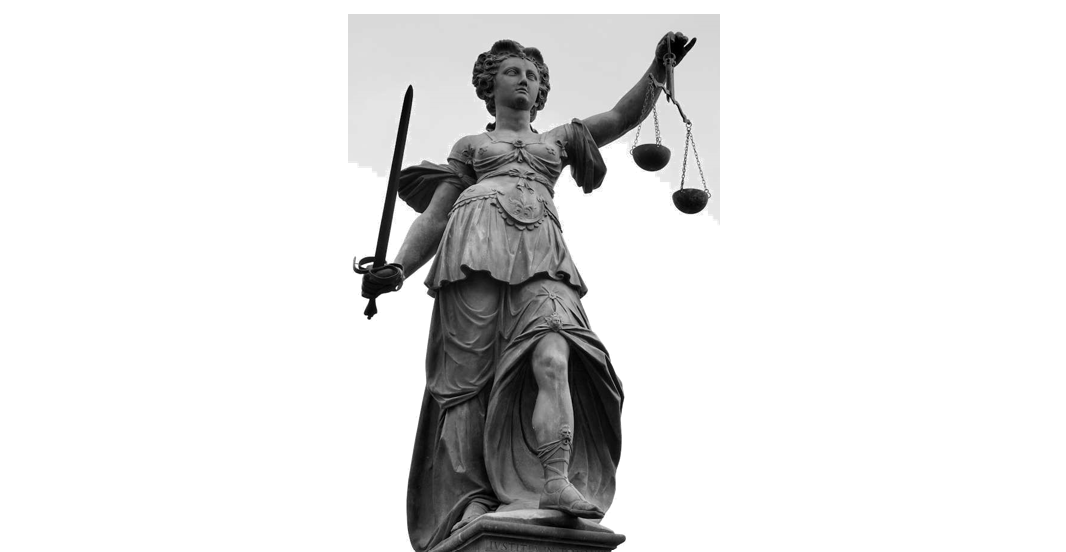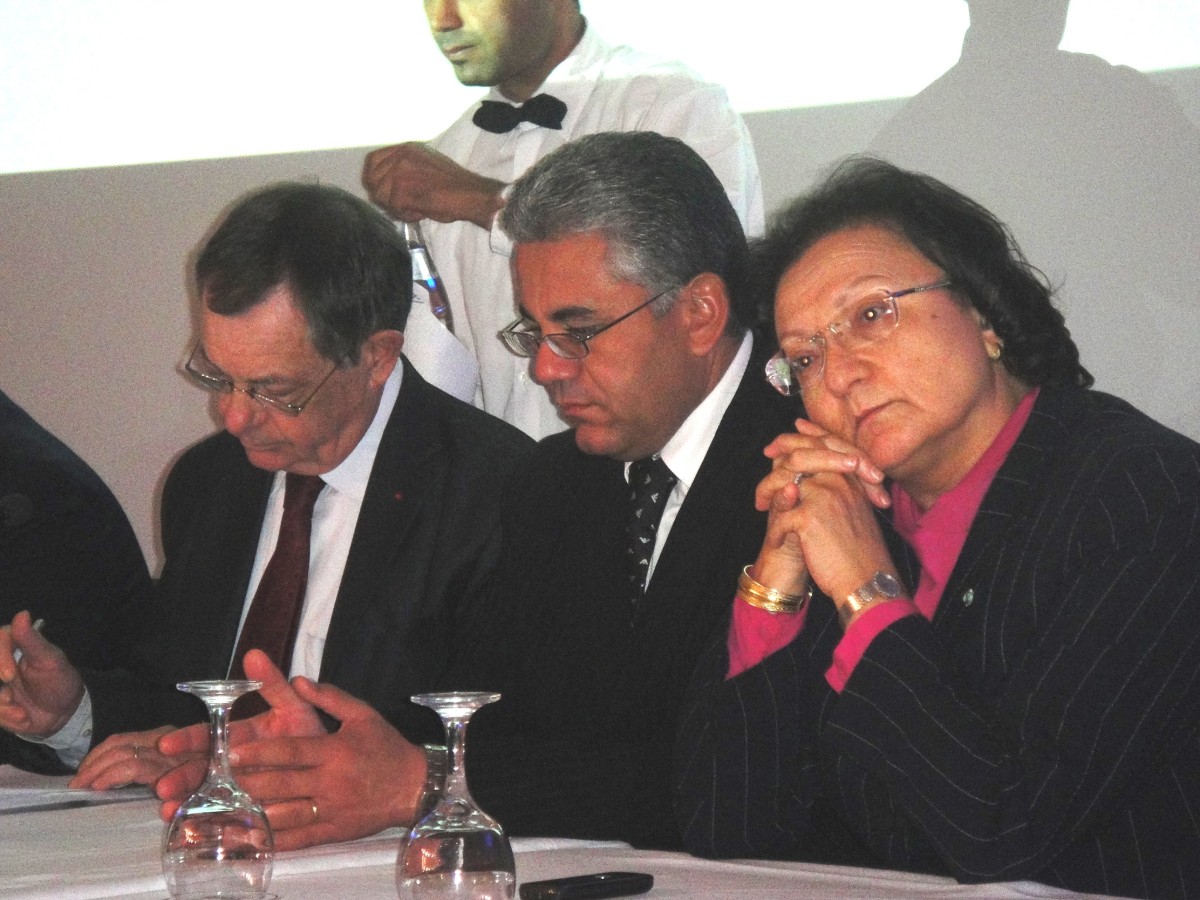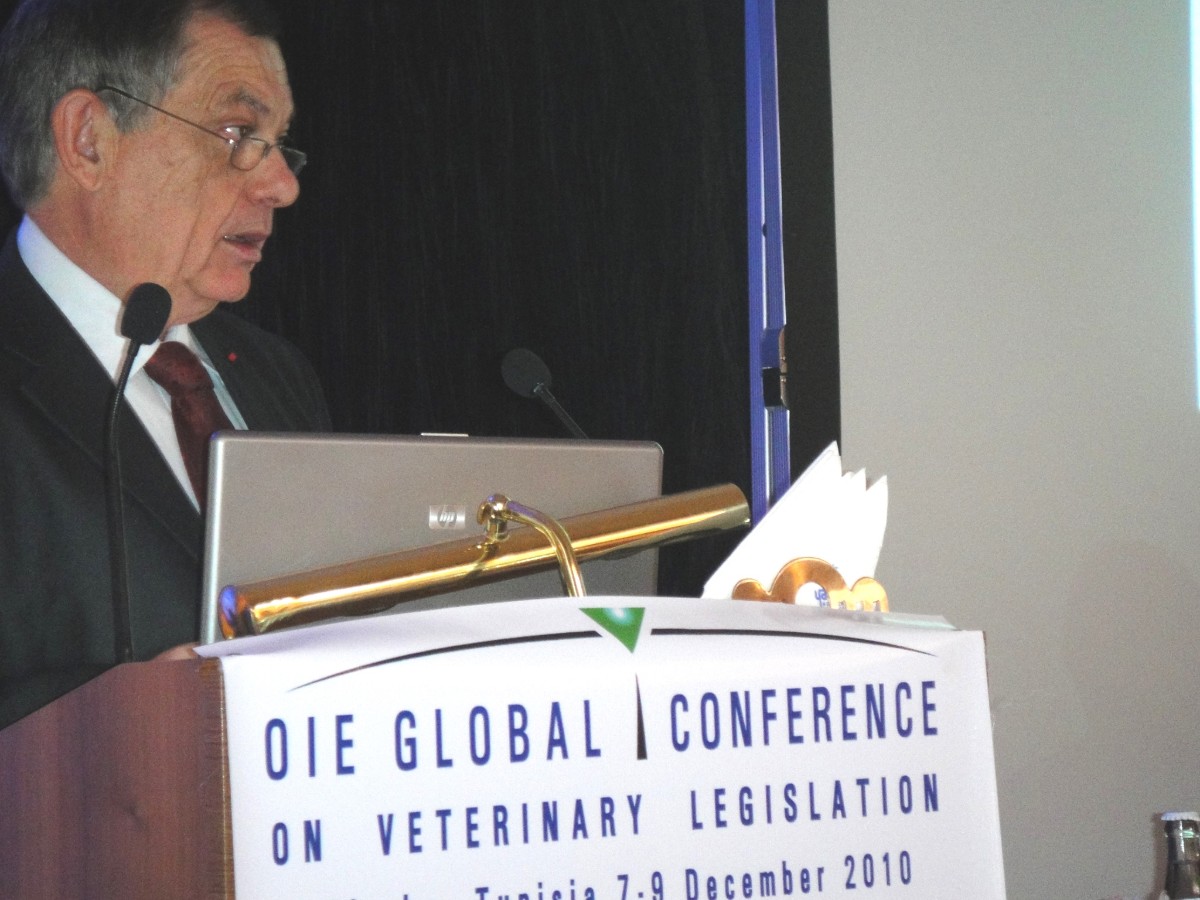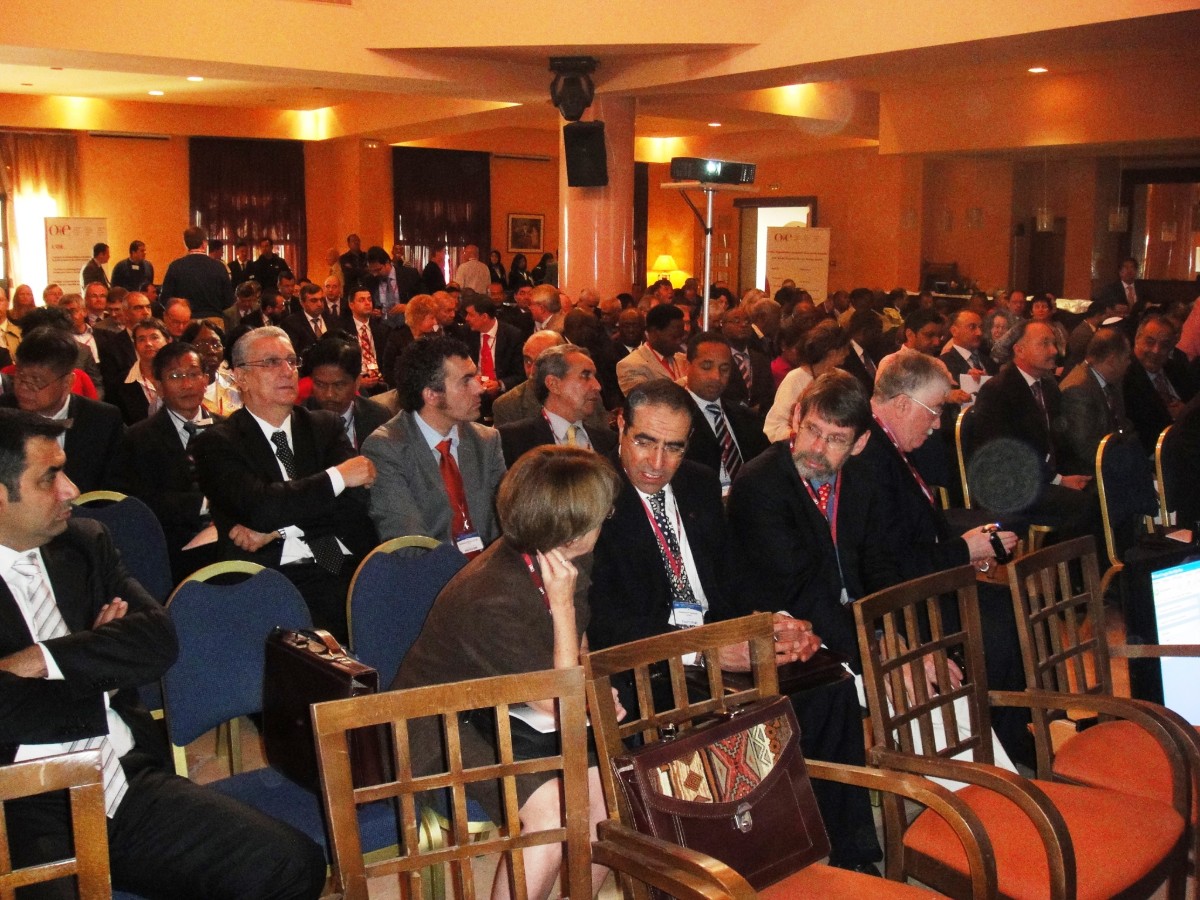



VETLEG 1 Djerba Tunisia
The first OIE global conference on veterinary legislation united more than 300 participants in Djerba, an island in the south of Tunisia, a few kilometers off the Libyan border. Opened solemnly by the Tunisian Minister for Agriculture, Marine Resources and Fisheries, H.E. Mr. Abdessalam Mansour, the participants and speakers, from all continents and during three days, focused their attention on veterinary legislation, from the current state of affairs at national and regional levels, to the tools that are being availed by OIE and other regional and international agencies, such as for example FAO, WHO and WTO to contribute to a better consistency of national legislations with international standards recommended by some of the institutions mentioned above.
Welcoming address by the OIE Director General, Dr. Bernard Vallat. Picture (c) P. Bastiaensen (OIE) 2010.
Other speakers specifically targeted legislation dealing with veterinary products (ANMV-ANSES, FDA-VICH, UEMOA-WAEMU) as well as initiatives taken towards harmonization of legislation within the European Union and MERCOSUR. Particular attention was given to the potential benefits of capacity building tools, as developed by various organizations (OIE, OIRSA, WTO-STDF).
Africa was represented by 36 countries, including the hosting country, Tunisia and countries of origin of several speakers from Botswana (SADC), Burkina Faso (UEMOA-WAEMU), Guinea, Uganda, Morocco (UMA), Namibia and Tunisia (host country).
In his short speech, the OIE President, Dr. Carlos Correa – Messuti asked for one minute of silence for two emblematic figures of the OIE which left us recently, Dr. Jean Blancou, former OIE Director General and Dr. Abdoulaye Bouna Niang, former OIE President and OIE Regional Representative for Africa.
The assembly ended up adopting a series of recommendations which are available here :
1. The need to increase the capacity of all countries worldwide to create or maintain national
animal health and veterinary public health systems that cover all national territories, with the
necessary infrastructure and can provide for surveillance, early detection and rapid response to outbreaks of aquatic and terrestrial animal diseases, including zoonoses, whether these arise through by natural or intentional events;
2. The emergence and re-emergence of animal diseases, of which some 75% are transmissible to humans, the growing threat of transboundary animal diseases, the impact of environmental changes and of the globalisation of commodities and movement of people, as well as the new societal demands in the fields of food security, food safety, veterinary public health and animal welfare;
3. That the mandate of the World Organisation for Animal Health (OIE) as an intergovernmental organisation with 177 Members is to improve animal health and welfare worldwide and to promote safe trade;
4. That good governance is of critical importance in enabling veterinary services to fulfil at least the basic missions recommended by the international community in order to improve animal health and welfare worldwide;
5. That the OIE provides to Members with the support of key partners such as FAO the global PVS Pathway for Efficient Veterinary Services under its mandate to strengthen capacities relevant to the veterinary domain, including for animal health and welfare, veterinary legislation, public health including food safety, biodiversity and protection of wildlife from disease, noting that the OIE will hold a Global Conference on Wildlife in 2011 and that recommendations from that conference will provide more details on the mandate and mission of the OIE concerning wildlife;
6. That veterinary legislation is a key component of efficient veterinary services;
7. That many countries, especially developing countries and countries with ‘in transition’ economies, do not have up to date veterinary legislation and are not, therefore, well placed to meet the needs of current and future health challenges and societal expectations;
8. That the important role of Veterinary Statutory Bodies to good governance of the veterinary profession is often overlooked;
9. The implementation of the global concept known as ‘One Health’, which aims to address health risks at the animal (domestic animals and wildlife) – environment– human interfaces;
10. The need for basic competencies for veterinarians, including in governmental services, including skills in diagnosis, epidemiology, food safety, animal welfare, veterinary legislation, management and leadership, which are not currently being provided by veterinary education in many countries;
11. The need for countries and institutions to work together to support countries that wish to modernise their veterinary legislation;
12. The OIE standards on the quality of Veterinary Services, specifically Chapters 3.1. and 3.2. of the Terrestrial Animal Health Code (Terrestrial Code), and the OIE Veterinary Legislation Guidelines, currently found on the OIE internet site;
13. That the OIE has created a global Veterinary Legislation Strengthening Programme (VLSP), as a step in the OIE PVS Pathway, which provides an opportunity for OIE Members that wish to modernise their legislation and to obtain financial and human resources to strengthen implementation of the legislation, to obtain specialised technical support and guidance from OIE trained and certified experts;
14. The opportunity to work within the framework established by several Regional Economic
Communities and regional organisations, such as OIRSA, to develop harmonised veterinary
legislation and rules, as a means to facilitate disease prevention and management and promote trade in animals and animal products at the regional level;
15. The need for all 177 OIE Members to support the application of the OIE standards for sanitary safety, in order to improve animal health globally and, through meeting the obligations of World Trade Organization membership and the SPS Agreement (as appropriate), promote safe international trade in animals and animal products globally;
16. The sometimes insufficient participation of private veterinarians and their associations, and insufficient development of public–private veterinary partnerships, in the overall prevention and control of OIE listed and emerging diseases;
17. The need for veterinary legislation to provide a sound basis to address challenges linked with the production, registration, distribution and use of veterinary products;
18. That the OIE is working to support Member Countries through the conduct of ongoing capacity building seminars in all regions, which aim to raise awareness and improve capacities of national Focal Points who are nominated by the National Delegate and under his/her control. In 2010 Members were asked to nominate Focal Points for animal production food safety; animal welfare; aquatic animals; disease reporting; veterinary products and wildlife. From 1 January 2011, Delegates will be asked to nominate or confirm a new Focal Point for communication;
19. That the OIE has developed a Twinning programme for laboratories and collaborating centres, as part of the OIE PVS Pathway, with the goal of improving the capacities of Members, particularly developing countries, for disease diagnosis and control and for participation in the standard setting process of the OIE with the ultimate objective of becoming a recognised OIE reference laboratory or collaborating centre;
20. That, following the First Global Conference on Veterinary Education (October 2009) the OIE convened an ad hoc Group on Veterinary Education, which has produced a report on the
minimum competencies required of Day 1 veterinary graduates to enable all countries to meet the OIE standards for efficient veterinary services (comprising both the public and private sector);
21. That a 2nd Global Conference on Veterinary Education will be held on 13-14 May 2011 (Lyon, France) within the framework of the celebration of the 250th anniversary of the veterinary profession.
1. That the OIE, with support from relevant international organisations such as FAO, continue to provide the PVS Pathway for efficient and effective Veterinary Services and all associated steps, including the Veterinary Legislation Support Programme, the Twinning Programme, the PVS Gap Analysis and the PVS follow-up missions;
2. That the OIE augment its standards and associated PVS critical competencies on veterinary medicinal products, dealing with capacities in the production, registration, distribution and use of veterinary medicinal products, to provide guidance to OIE Members wishing to update their legislation and secure the human and financial resources required to implement appropriate modern legislation on this subject and that the OIE develop guidance to help developing countries establish a basis for recognising the decisions to approve and register veterinary products made by other relevant competent authorities and thus take advantage of existing assessments of product safety and efficacy information;
3. That the OIE propose the adoption and publication of the current Veterinary Legislation Guidelines as standards in the Terrestrial Code ;
4. That the OIE continue to work closely with Member Countries, Regional Economic Communities and other organisations to support efforts to develop veterinary legislation and
rules that are harmonised, as appropriate, at the regional level. The methodology should be in consultation with relevant international organisations in order to ensure global consistency;
5. That the OIE further strengthen its activities in providing capacity building to Focal Points, to support the National Delegate to meet his/her rights, obligations and responsibilities and to strengthen the capacities of OIE Member Countries, particularly developing countries, to participate in the standard-setting process. Governments and relevant organisations and donors should provide adequate resources for support programmes using the guidance of the OIE;
6. That the OIE continue working with regional and international organisations, such FAO, and donors, veterinary associations and consumer organisations, to raise public awareness of the important role of the veterinary profession and to convince governments and international donors of the need to invest in veterinary services as a Global Public Good;
7. That the OIE present the recommendations of this conference to the SPS Committee;
8. That the OIE use the principles established under the successful Laboratories Twinning Programme and prepare recommendations for a pilot twinning between Veterinary Education Establishments in developed and developing countries;
9. That the OIE extend the current concept for laboratory twinning and prepare a project to be submitted to donors for a pilot twining programme between Veterinary Statutory Bodies (or equivalent body complying with the OIE Terrestrial Code definition) in developed and developing countries; and that the OIE organise with the support of the World Veterinary Association a global conference for Veterinary Statutory Bodies;
10. That the OIE continue its work on veterinary education and present final recommendations to the OIE General Assembly on the Day 1 minimum competencies required for countries to meet the OIE standards on competent Veterinary Services (as set out in Terrestrial Code Chapters 3.1. and 3.2.) and on the quality of veterinary education. The required minimum competencies for veterinarians, including in governmental services, include skills in diagnosis, epidemiology, food safety, animal welfare, veterinary legislation, management and leadership;
1. That Members take steps to improve compliance with international standards and the quality of national Veterinary Services by following, when needed, the OIE PVS Pathway, as appropriate to the national and regional context;
2. That national veterinary authorities of countries that have done a PVS evaluation, consider the findings of the evaluation and, where appropriate, apply the relevant next steps, including a PVS Gap Analysis to address shortcomings and prepare a basis for requesting support of donors, where appropriate, and a review of veterinary legislation, to obtain general compliance with OIE and other relevant international standards;
3. That Members who recognise an urgent need to modernise the national veterinary legislation consider requesting an OIE Veterinary Legislation Identification Mission at the same time as they request a PVS Gap Analysis, providing an opportunity for more rapid progress. In that context, Members should create a national task force with lawyers and official veterinarians to receive, as appropriate, OIE support within the framework of a Memorandum of Understanding between the country and the OIE;
4. That countries, regional organisations and Regional Economic Communities consider
requesting an OIE veterinary legislation mission at the regional level, in addition to national
missions, to help to achieve progress in regional harmonisation, as appropriate, of veterinary legislation and rules and thereby facilitate disease prevention and control, and regional trade;
5. That those OIE Members who have not yet done so commence the process of creating an
autonomous Veterinary Statutory Body (VSB) complying with the OIE Terrestrial Code definition, including as a first step providing enabling national legislation for the establishment of a VSB with clearly defined powers and objectives to regulate the whole veterinary profession, in accordance with OIE standards as contained and referred to in Article 3.2.12 of the Terrestrial Code;
6. That OIE Members provide an enabling national legislation for the establishment of private veterinary sector organizations and their participation in all relevant animal health activities of the country, including clear definitions of the terms ‘veterinarian’ and ‘veterinary paraprofessional’ in the legislation;
7. That the responsible national, regional and local veterinary as well as other competent authorities, such as Veterinary Statutory Bodies, support the development and implementation of programmes to evaluate and, if necessary, improve the education of veterinarians in their respective jurisdictions, taking into account OIE recommendations on competencies in veterinary public health, including food safety, epidemiology, transboundary diseases, animal welfare, veterinary legislation and other ‘Day 1’ requirements for effective performance within the context of national Veterinary Services;
8. That all Members nominate Focal Points in the areas proposed by the OIE and that the Focal Points be supported to attend the relevant OIE regional capacity building seminars;
9. That developed country Members with an OIE Reference Laboratory or an OIE Collaborating Centre give favourable consideration, if possible, to participation in the OIE Twinning Programme;
10. That OIE Members that are also World Trade Organisation (WTO) Members increase their efforts to meet WTO obligations for notification regarding the development or modification of their Veterinary Legislation having a bearing on sanitary measures relevant to international trade in animals and animal products (excepting where the new measures are aligned with the OIE standards);
11. When preparing national and regional strategic plans, Members should seek appropriate support and funding from donor agencies using the auspices of the OIE.
All pictures (c) P. Bastiaensen (oie) 2010, unless mentioned otherwise.




